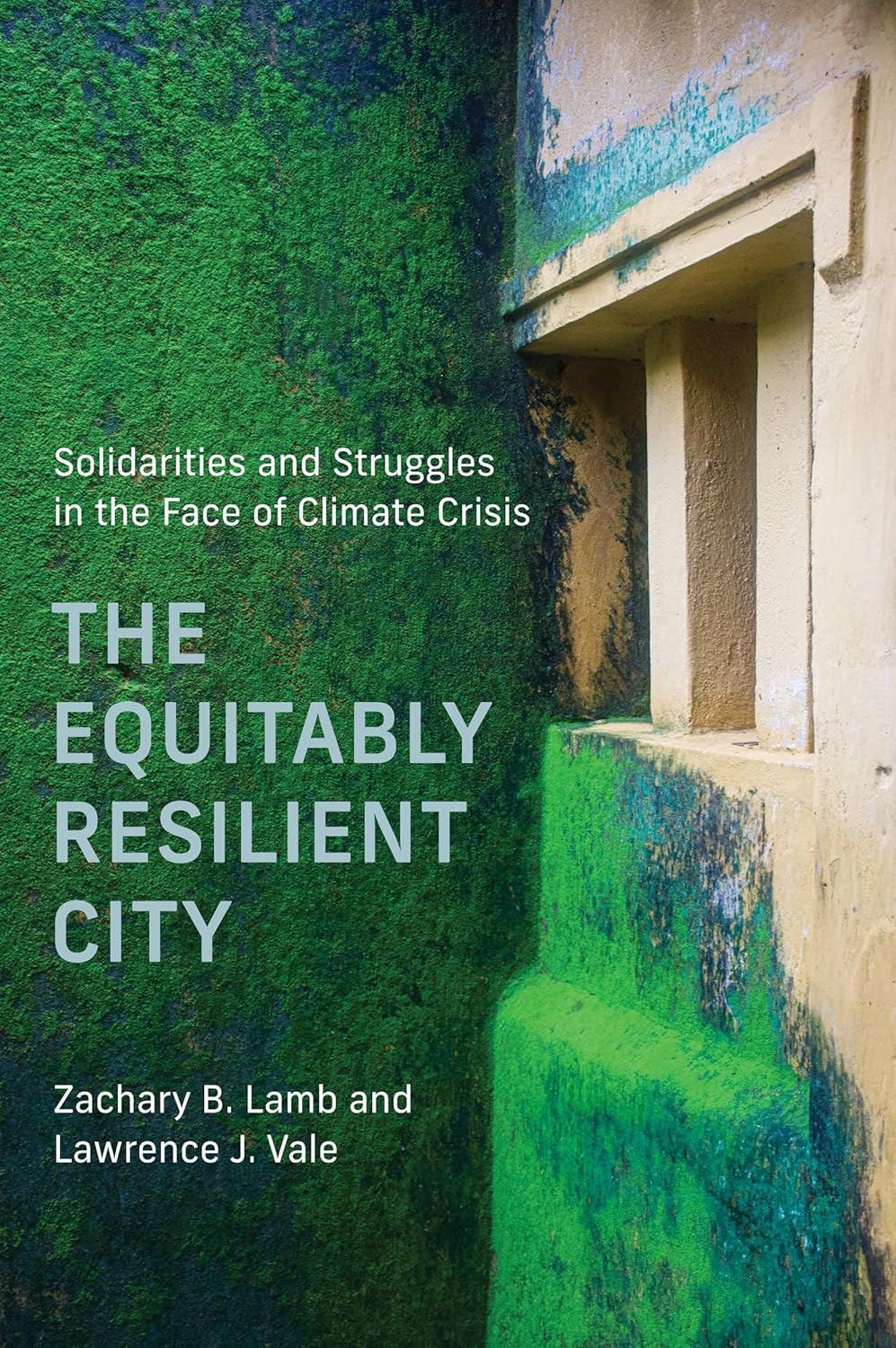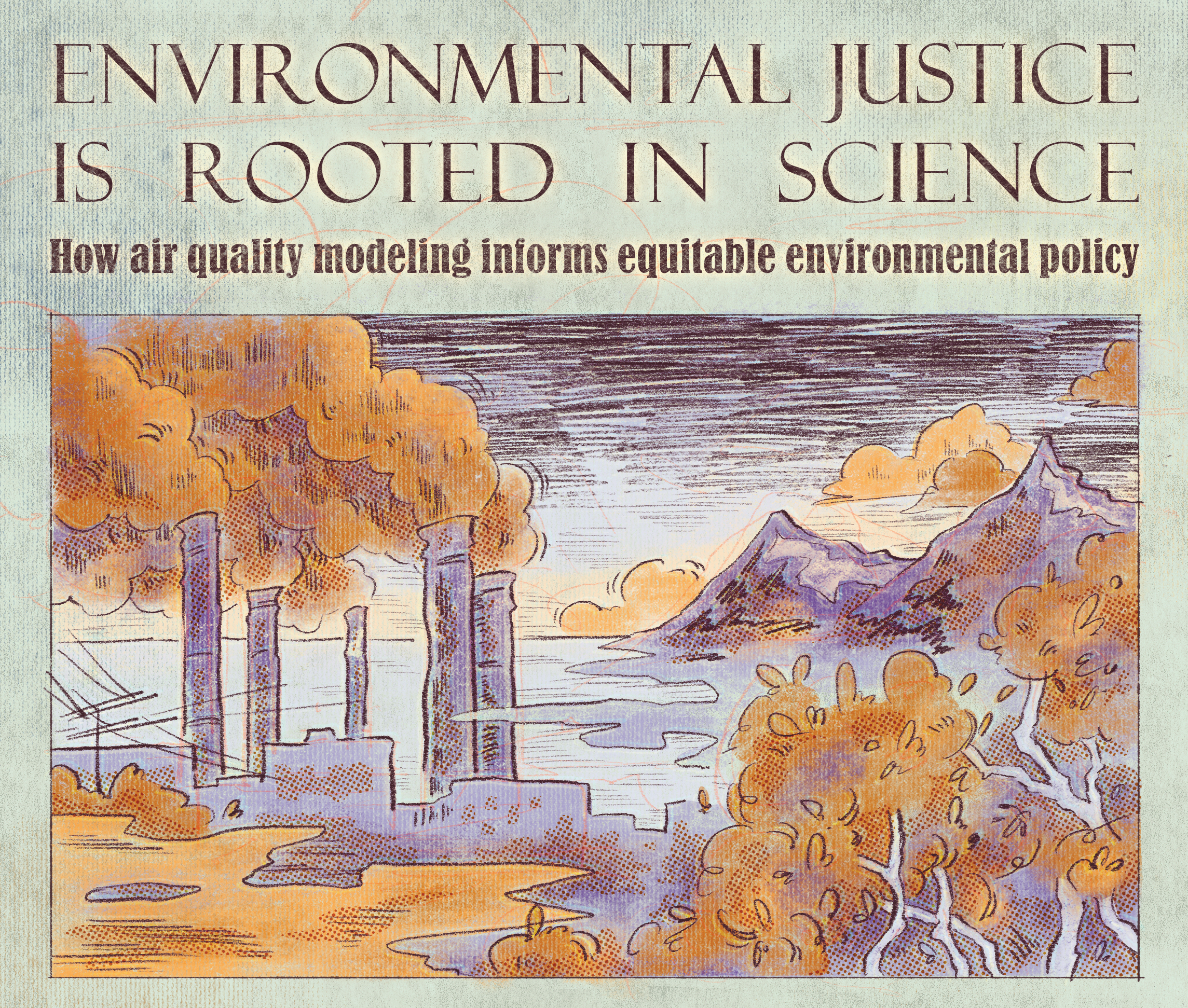
When you flip a light switch, you probably don’t think about where that electricity comes from. In Berkeley, there’s a good chance that your electricity is provided by East Bay Community Energy, a local, community-run power sup-plier that typically sources clean, renewable energy from solar, wind, or hydroelectric sources. While it would be ideal for the rest of the state, and the whole country, to run entirely on clean energy sources, that is currently not the case. In California last year, only 31 percent of the state’s energy came from renewable sources, compared to 35 percent from natural gas alone. Renewable energy sources can be regenerated and reused, unlike finite sources such as coal, oil, or natural gas. Meanwhile, the use of non-renewable, dirty energy sources generates byproducts that are harmful to our climate, raising global temperatures and leading to worldwide effects such as increases in natural disasters, changes in weather patterns, and rising sea levels. At the more local level, dirty energy sources such as natural gas refineries and coal power plants generate local air pollution that disproportionately affects the surrounding communities. These elevated levels of airborne pollution have been shown to be associated with higher rates of heart disease, lung problems, asthma, bronchitis, preterm birth, birth defects, obesity, and immune system complications.
California is well known for its environ-mental and clean energy leadership, aggressively pursuing renewable energy since the 1970s. In 2018, California generated only 3 percent of its electricity from coal—none of which was mined or burned in the state. This milestone was made possible by two landmark energy bills, AB-32 and SB-1368, which created a cost incentive and standards for energy generators to significantly reduce their emissions. Since the bills were passed in 2006, no new coal plants have been built in California. In late 2018, California set another ambitious milestone by passing SB-100, mandating that 100 percent of the state’s electricity come from carbon-free sources by 2045.
However, the benefits of these energy regulations have not been evenly distributed throughout California. In regions like the San Joaquin Valley, residents have little access to energy of any sort—many areas don’t even have natural gas lines—and rely on monthly tanks of propane or wood. Not only are these dirty fuel sources expensive, they also increase local air pollution, leading to some of the worst air quality in the nation. Given California’s expansion of natural gas production in recent decades, why does the state still have regions without proper energy infrastructure?
“There was a historical reluctance—substantially rooted in racism—to develop infrastructure in these unincorporated areas with low population concentrations that were mostly non-white and often Spanish-speaking,” explains Berkeley Law professor Claudia Polsky. Those with greater financial security tend to choose to live in more pleasant places further from sources of air pollution. Furthermore, when new polluting sources are developed, they are predominantly built near low income communities that don’t have the resources to fight against them. As a result, poorer people tend to live near the sources of air pollution. These problems exemplify ongoing energy access and health inequalities faced by low income and minority communities.
It has been widely studied and verified that socioeconomically disadvantaged populations also experience disparities in lifestyle behaviors, including higher rates of smoking, less frequent exercise, poorer diet. Because populations living near these local sites of air pollution tend to be more economically disadvantaged, it can be challenging for researchers to differentiate between the impact of these behaviors and the effects of the air pollution itself. Therefore, scientists at UC Berkeley must use biochemical tools to examine changes at the cellular level, while also carefully accounting for socioeconomic factors and demographics, as they study the influence of air pollution on public health in these communities.
Biochemical changes trigger health issues
Professor Katharine Hammond’s training as a chemist provides her with a unique perspective on air pollution in her work at the UC Berkeley School of Public Health, where she has linked pollution to changes in the immune system and gene regulation. Hammond’s interdisciplinary background allows her to lead a coalition of 25-30 researchers from universities across California working on the Children’s Health and Air Pollution Study (CHAPS) in the San Joaquin Valley. Over the past two decades, CHAPS has focused on understanding and reducing the risks of air pollution exposure on children.
Initially, Hammond’s group focused on T-regulatory cells, a type of T cell that acts as a traffic cop to dictate the body’s immune response to foreign invaders. The innate immune response is the first part of the immune system to be activated by injury or infection: “If you cut yourself and don’t clean it out, your body will respond generically,” explains Hammond. This is a one-time response that does not provide long-term immunity against a disease-causing organ-ism such as a bacteria or virus. The second part of the immune system to be activated is called the adaptive response, and it provides long-term immunity. The adaptive immune system remembers chemical markers on invasive microbes to help recognize and defend against them in the future. Different types of T cells, including T-regulatory cells, help maintain balance between these two types of immune responses and play a critical role in protecting the human body from a wide variety of diseases. By studying these cellular systems and correlating their functions with air quality data, Hammond’s team showed that exposure to the air pollution leads to dysfunctionality among T cells. Improper T cell activation can lead to autoimmune diseases, where the immune system mistakes itself for a foreign invader. As a result, it attacks its own cells, leaving the body defenseless and vulnerable to infection.
Advances in our understanding of the human genome have allowed scientists to look beyond T cells and dive deeper into the underlying genetic code that regulates these types of immune responses. These advances led to the discovery of a phenomenon called DNA methylation, where a chemical group attaches to a DNA molecule and acts as a switch to turn different functions on and off. This process performs significant roles in development, for example signaling to a new cell whether it will grow into a lung, heart, or skin cell. Errors in this mechanism, such as hypermethylation, where too much methylation occurs, can have a variety of serious health consequences such as the growth of cancer cells or birth defects.
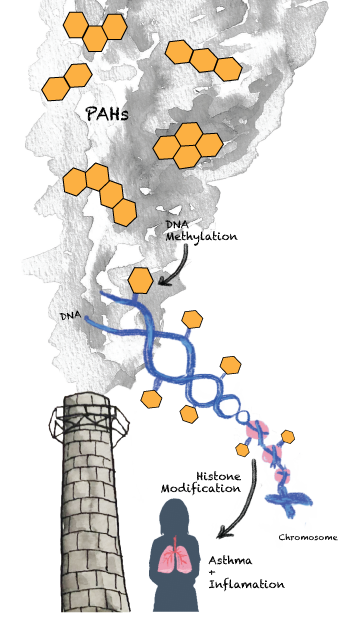 Polycilic aromatic hydro-carbons (PAHs) present in air pollution cause DNA methylation, making genes unable to properly reduce inflammation, aggravating asthma.
Polycilic aromatic hydro-carbons (PAHs) present in air pollution cause DNA methylation, making genes unable to properly reduce inflammation, aggravating asthma.
To bridge the gap between air pollution measurements and the health effects in children, Hammond’s group recruited study participants from Fresno, California, a region that has some of the country’s worst particle pollution and ozone levels. Fresno County has a childhood asthma rate of 24 percent, higher than the state average of 17 percent. Researchers collected health information and blood samples from 198 children to investigate levels of four common pollutants: carbon monoxide (CO), ozone (O3), nitrogen dioxide (NO2), and fine particulate matter (PM2.5). By conducting hourly measurements of air pollution levels at monitoring stations in Fresno, they were able to develop models to estimate each child’s exposure to these pollutants every single day. Children are a particularly vulnerable population because they are still developing, and exposure to chemicals or pollutants may interfere with proper development. Compared to adults, children also breathe more air relative to their body size, effectively exposing them to a higher dose of any airborne pollutant.
Hammond’s research shows that exposure to polycyclic aromatic hydrocarbons (PAHs), a common component of air pollution, in children has led to a higher rate of DNA methylation. Specifically, this methylation takes place on Foxp3 and IL10, two genes that play a critical role in pre-venting or dampening the body's immune response. When the body cannot properly regulate inflammation—which occurs with increased methylation of Foxp3 and IL10—it is prone to many diseases, including severe asthma, which Hammond found in the Fresno County children. To reduce the burden of severe asthma in these communities, scientists must find a way to reduce the sheer quantities of these pollutants, but it remains a daunting task. These particles are found virtually every-where, suspended in the air, at concentrations up to one million particles per cubic foot. “Cleaning up the air is a very difficult and virtually impossible task,” explains Hammond. Given the health risks, the best way to protect vulnerable populations such as children from airborne pollution is to prevent it from being emitted in the first place.
Nowhere to go: impacts on minority communities
While it has been widely accepted that the pollution from these carbon-based energy sources is harmful, it has been challenging to systematically study the relationship between air pollution and socioeconomic factors. Looking at changes in emission sources and reductions in emission sources at a local level is necessary to quantify the short-term public health benefits of changes in our energy infrastructure. At UC Berkeley’s Department of Environmental Science, Policy, and Management (ESPM), Professor Rachel Morello-Frosch has leveraged public data to construct a natural experiment to study this issue. Using over 57,000 birth records from the California Department of Public Health and data from the US Energy Information Administration from 2001-2011, Morello-Frosch’s group examined the number of preterm births before and after the retirements of two coal and six oil power plants.
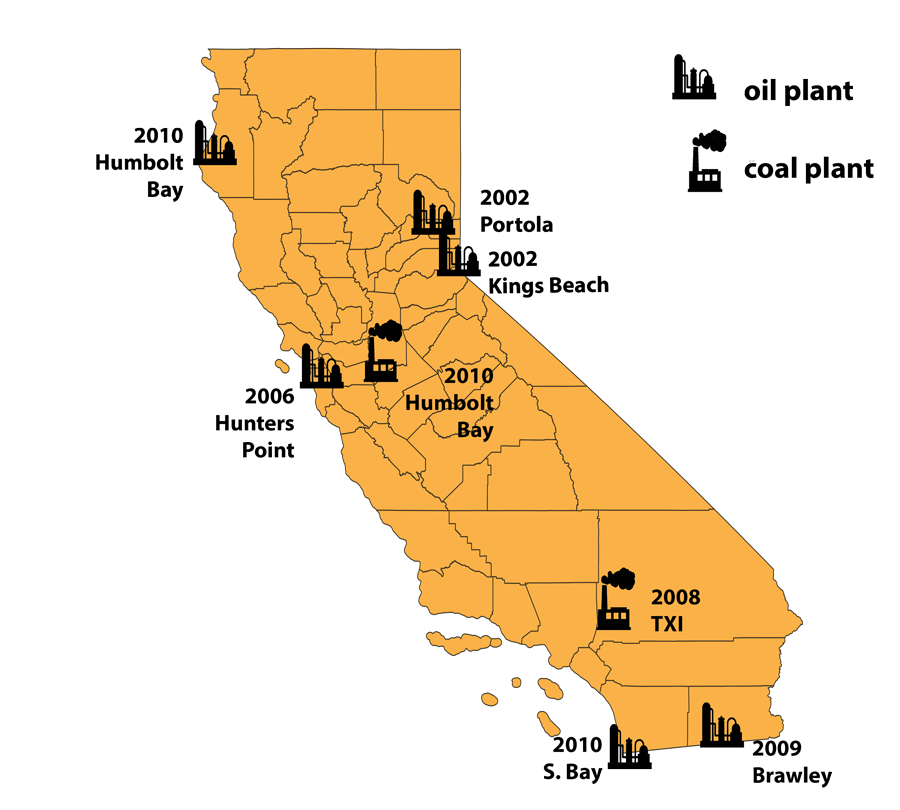 Location of the two coal and six oil plants in the study along with their retirement dates.
Location of the two coal and six oil plants in the study along with their retirement dates.
There are various tactical reasons for focusing on preterm births in this study. Air pollution increases the risk of preterm birth by altering normal gestation progress and increasing the mother’s susceptibility to infection. The World Health Organization estimates that preterm births, defined as a baby born up to 6 weeks before the normal 37 weeks of gestation, cost about $2 billion in health care costs worldwide. Furthermore, preterm birth is a prime target for medical researchers, as it can lead to long-term health problems well into adulthood.
Previous studies have focused on nonspecific types of air pollution such as traffic emissions, but few have addressed the relationship between stationary emissions such as power plants. Even among those that have found a correlation between adverse birth outcomes and proximity to power plants, none have deeply examined the breakdown of this correlation on the basis of racial and socioeconomic status. Pregnant women in these disadvantaged populations typically experience additional factors, such as food insecurity, poverty, and other health stresses, that can also con-tribute to preterm birth. Because power plant retirements should affect all nearby residents equally, Morello-Frosch’s group was able to control for these external influences in their study. Therefore, any observed change could be more definitively attributed to the closing of nearby power plants.
To validate the results, it was necessary to have a group to control for variables not related to air pollution. Morello-Frosch separated the pregnant women into three groups: those living within 5 kilometers, 5-10 kilometers, and 10-20 kilometers of a plant. Of these, the 10-20 kilometer group was used as a control for secular trends. “At distances much farther away from the plant, we assume any changes that we are due to broader trends over time in preterm birth rates rather than the plant itself,” explains Morello-Frosch.
Before retirement, the eight power plants in this study emitted approximately 177 tons of nitrogen oxides (NOx) per year; this fell to just 4 tons per year after retirement. Correspondingly, preterm births decreased from 7 to 5.1 percent after retirement, with larger reductions in the groups closer to the power plants. For context, “if you developed a drug that reduced preterm births by 2 per-cent, that would be considered a blockbuster drug,” explains Morello-Frosch.
 On average, preterm birth rates have decreased by almost 2% with the retirement of power plants, with the greatest decrease in preterm birth rates closer to the plant.
On average, preterm birth rates have decreased by almost 2% with the retirement of power plants, with the greatest decrease in preterm birth rates closer to the plant.
These geographic considerations are especially relevant given that minority communities tend to live closer to these polluting sources. Within the group of pregnant women living within 5 kilometers of a power plant, non-Hispanic black mothers lived the closest, on average 2.1 km away. Hispanic, Asian, and non-Hispanic white mothers lived on average 2.8, 3.1, and 3.4 km away, respectively. Further analyses within each distance group showed stronger associations between power plant retirement and preterm birth for non-Hispanic black and Asian mothers. This finding did not come as a surprise to Morello-Frosch: “Because rates are already high among these groups that are vulnerable to preterm birth, environmental interventions like this probably have more room to see an improvement.” Their study provides evidence that cleaner energy policies that encourage plant closures have the potential to not only improve overall birth outcomes, but also reduce racial disparities in preterm birth.
From research to action
Identifying these health problems is only the first step towards changing the status quo. The studies conducted by researchers such as Morello-Frosch and Hammond are critical to inform issues of environmental health and environmental justice. While local residents living in nearby low income and minority communities are the ones who will be most directly affected by these types of projects, they may lack the legal or scientific expertise to address the problem alone. “Very often, we need a mix of community groups and affected individuals with local knowledge and scientists who bring a lot of data and have credibility with regulators,” explains Polsky. At UC Berkeley, Polsky runs the Environmental Law Clinic, which works closely with scientific experts on campus and with environmental justice organizations to build coalitions and bring scientific research into legal and policy spaces to effect change.
The Environmental Law Clinic pro-vides law students with hands-on experience tackling issues of both environmental health and environmental justice. In the San Joaquin Valley, a historically energy-poor and politically-disempowered region, these issues go hand in hand. Residents not only face the challenge of limited energy access, but must also live with the byproducts of local pollution from energy generation. In this region, home to many mega-dairies, California is scaling up biomethane production as part of its statewide clean energy goals. The California Public Utilities Commission (CPUC), California Air Resources Board (CARB), and the California Department of Food and Agriculture (CDFA) recently awarded $319 million to establish and fund six dairy bio-methane projects for 20 years.
Biogas production is an important piece of the state’s renewable energy goals—not to mention, a big diversion of organic waste from landfills. Manure from local dairies is transported to digestion facilities where it can be processed and burned to produce energy. This energy may be used as electricity, or power alternative processes such as the production of ethanol, which can then be blended with traditional gasoline to create a low-carbon fuel. On a large scale, use of this biofuel is a clean, climate-friendly pro-cess that highlights California’s creativity and dedication to a carbon-neutral future. However, it may present several issues for local residents near these facilities in the San Joaquin Valley. First, there remains some scientific uncertainty around
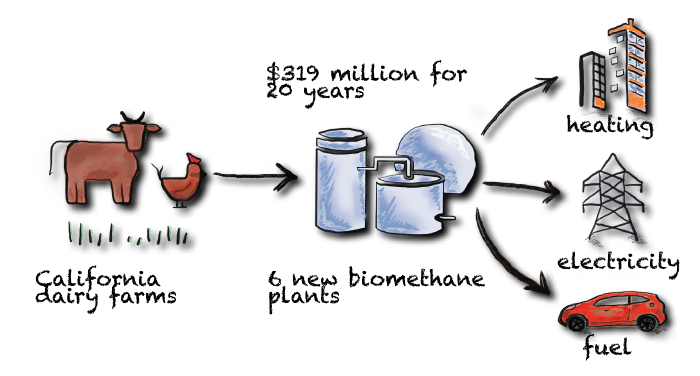 San Joaquin Valley plans for using biogas from dairy farms to produce methane for electricity, heating, and low carbon-fuel.
San Joaquin Valley plans for using biogas from dairy farms to produce methane for electricity, heating, and low carbon-fuel.
the use of existing natural gas pipelines to transport biomethane, given their different chemical properties. Without rigorous study and proper precautions, using natural gas pipelines could pose additional risks such as explosions. Furthermore, there is a concern about an increase in trucking, particularly diesel trucking, to service this new industry, which will create significant local air pollution. In response to these concerns, UC Berkeley’s Environmental Law Clinic has pushed for more study and greater safety margins to ensure that these changes don’t endanger local residents. While this project may benefit California as a whole, it still requires collaboration between scientists and lawmakers to ensure that we are not disproportionately harming the state’s most vulnerable residents.
New science for a changing world
Even though researchers have made significant advances in recent years by developing tools and partnerships to study air pollution from dirty energy sources, they still face many challenges and unanswered questions. For example, “people are still worried about traffic-related air pollution like cars and trucks along major roadways,” says Morello-Frosch. While it’s much less common for these roadways to shut down compared to power plants, transitions to underground freeways or major disasters like earthquakes could provide opportunities for similar natural experiments like the one conducted by Morello-Frosch’s group on power plant closures.
At the genetic level, more research is still needed to better understand the unique DNA markers for diseases, like asthma, to correct and prevent damage from pollution. New evidence from studies by Hammond and other researchers suggest that higher exposures to airborne pollution may contribute to obesity in children. This, as well as other chronic effects, will need to be studied more closely as these children age to determine the potential long-term impacts of living with polluted air.
Compared to the rest of the country, California’s population is both young and diverse, making it particularly vulnerable to the detrimental health effects of long-term air pollution. Therefore, it is in the state’s best interest to develop a thorough understanding of how our air pollution impacts different populations throughout the state, particularly in the most vulnerable communities. As communities become increasingly dense and urban, it is important to consider detrimental effects on schools, where young children spend a significant amount of time outdoors. Despite a 2003 state law banning new school construction within 500 feet of highways, many older schools still fall within this range, exposing their students to dangerous air quality levels. Furthermore, minority and low-income students often attend schools in urban environments, which are much more likely to be located near sources of pollution.
Even if California accomplishes its environmental and clean energy goals to generate 100 percent of its electricity from carbon-free sources and move to electric vehicles, this transition will take time. Research has already identified short and long-term health consequences of carbon-based energy, which will only worsen if policy makers do not take measures to quickly minimize the number of power sources that may have negative effects on the health of those living nearby. Through their continued study of these problems, researchers at UC Berkeley can not only help highlight preventable causes of the health problems that plague minority communities in California, but also persuade other cities around the world to transition to cleaner energy sources for a healthier future.
Christopher Jackson is a graduate student in chemistry
Design: Katya Rakhmatulina
This article is part of the Fall 2019 issue.
